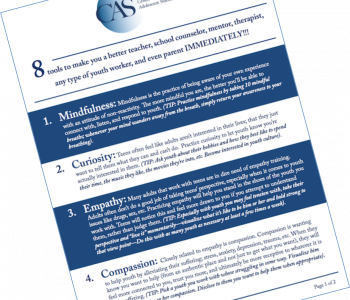

Catharine Hannay, MA
Catharine Hannay is the founder of MindfulTeachers.org and the author of Being You: A Girl’s Guide to Mindfulness, a workbook for teen girls on mindfulness, compassion, and self-acceptance.
3 Tips for Managing Compassion Fatigue and Empathic Distress
The narrator of the story “Standard Loneliness Package” works at a call center in Bangalore, experiencing other people’s pain for twelve dollars an hour. (Official company motto: “Don’t feel like having a bad day? Let us have it for you.”)
“Pain is an illusion, I know, and so is time, I know, I know, I know. The shift manager never stops reminding us. Doesn’t help, actually. Doesn’t help when you are on your third broken leg of the day.”
(Charles Yu, Sorry Please Thank You, p. 1)
Of course none of us can really feel someone else’s physical pain. But it’s all too common in the helping professions to take on the burden of others’ emotional pain.
During her clinical training rotations in graduate school, Dr. Teri Lawler provided counseling to children and families in crisis.
“My challenge was that I absorbed the pain of many of the clients that I saw as if it were my own. My heart broke at every session and by the end of my clinic rotations, I could barely breathe. […] I found myself frequently tearing up in anticipation of appointments. I worried so much about my clients and their families between sessions that it interrupted my sleep.”
Dr. Lawler tried to “anesthetize and disconnect” herself from the trauma but realized that
“it was absolutely unnatural to cease feeling and I did not want to continue like that in my personal life or in my work. I was certain that I could be more valuable by feeling with others without letting the hurts consume me or those around me.”
(Educating Mindfully: A Field Guide for Mindfulness in Schools, p. 294)
“Feeling with others without being consumed” is one of the biggest challenges among therapists, educators, healthcare workers, and other professional helpers. Over the past 30 years, I’ve seen far too many kind, well-intentioned people become overwhelmed by the endless need of their students, patients, or clients.
- Some of them leave the field because it’s taking too much of a toll;
- Some gradually sink into cynicism or depression; and
- Others do the bare minimum at their jobs, resenting the long tedious years until retirement.
On the other hand, I’ve also seen many people who are able to find healthy, sustainable ways to serve others.
Based on what I’ve observed over the years, as well as many discussions with friends and colleagues, here are three tips for healing from and reducing compassion fatigue and empathic distress.
Tip #1. Keep Your Emotional Armor Handy
“You’re such an empathetic child, his aunties had always told him. It’s very sweet, the way you seem to feel what other people feel, as if it were happening to you. Sometimes it didn’t feel sweet. Sometimes bearing other people’s hearts felt less like a kindness and more like a poltergeist. […] To let too many stories in—it will undo you. You could not bear it.”
(Thistlefoot, GennaRose Nethercott, p. 183; p. 116)
Feeling others’ suffering too deeply and too often will inevitably lead to distress. In order to protect yourself, you may need to put on your emotional armor from time to time.
If you prefer a different image, you could imagine:
- putting on a firefighter’s suit, so you can help others while protecting yourself from the heat and flames;
- wrapping your heart with bubble wrap—not to keep anyone else out, but to keep yourself from shattering; or
- setting up a boundary wall, with a gate so you can choose how much to let in at any given moment.
Or you could simply remind yourself, “It’s not my job to feel their pain. It’s my job to understand it.”
Here’s another way to think about this: “The goal is to make space for the pain, not to carry it.” As psychologist Whitney Goodman explains:
“When you make space, you sit with the person, empathize, acknowledge, ask where you can be of service, and validate. Taking on their pain will be heavy and burdensome. It also won’t help them or you.”
(Toxic Positivity, p. 208)
Tip #2. Recognize When You’ve Reached Your Limit
“In traditional Native American teaching, it is said that each time you heal someone you give away a piece of yourself until at some point, you will require healing. The journey to become a medicine man or woman (or a professional counselor) requires an understanding that the healer at some point in time will become wounded and require healing.”
Mark Stebnicki, Q&A: Empathy Fatigue
You may feel like you’ve been giving too much of yourself away. Or you may feel like you’re full to capacity and can’t take in any more suffering. When I feel this way, my motto is: “I’ve reached my saturation point.”
You may have reached your saturation point for the day, or for the week, or with a particular type of student, patient, or client.
I spoke with a therapist who’d reached his limit working in a hospital mental health ward. He was thriving in his new job at a university counseling center.
And a health aide at a nursing home told me she was looking for a job at the local children’s hospital. She said, “I guess I’m selfish because I’m worn out working with the elderly and I want to work with kids with cancer instead.” As I reassured her, that isn’t remotely selfish. (How many people actively seek out children with cancer?!)
If you’ve reached your limit, that doesn’t make you a bad person, and it doesn’t mean you’re bad at your job. It’s just time to shift your focus, either by taking the evening off or by working in a different environment.
Tip #3: Concentrate on What You Can Control
When psychologist Leeat Granek interviewed oncologists at different stages of their careers, she made an interesting discovery:
“[Some] would drag themselves into patients’ rooms, consumed by a sense of failure. They would cry in the car on the way home. Some would excoriate themselves, wondering whether they should have done something differently. Some shut down emotionally. […]
Not all oncologists responded in dysfunctional ways, though. Some described how patients’ deaths molded and humbled them, helping them to be more present. Confronting loss made them more careful, more respectful, and less willing to accept the status quo. They became activists on their patients’ behalf, whether this meant getting approval for a medication that an insurance company didn’t want to pay for or spending time talking with a family about how to care for a loved one during his final days. The doctors derived a sense of fulfillment from caring for the dying.”
(Dr. Ronald Epstein, Attending: Medicine, Mindfulness, and Humanity, p. 150)
You might not face the deaths of those you serve, but you likely face many other devastating situations you can’t control.
As Jennifer Gunn explains in an article on “Self-Care for Teachers of Traumatized Students”:
“It’s common for teachers to feel a perpetual sense of failure when they aren’t able to fix all of the ills and woes of their students. […] Identify what you wish you could do versus what you can actually do. You cannot eradicate or prevent all suffering for your students. But you can show up each day, support your students, advocate for them, and love them.”
Conclusion
Realistically, you probably can’t completely avoid experiencing compassion fatigue and empathic distress. If you’re a sensitive person who cares about others, there will inevitably be days or months when you feel overwhelmed by all of the trauma and suffering. However, it is possible to become more conscious of your limits and more aware of how to balance your own needs with the needs of those you serve.
You’ll find many more suggestions in the following posts:

